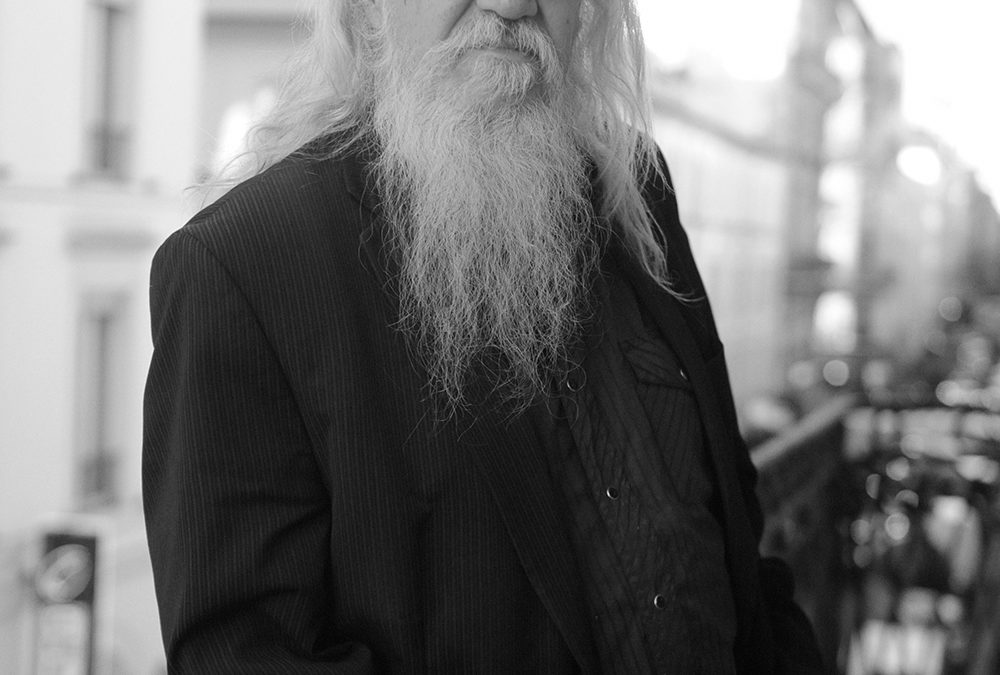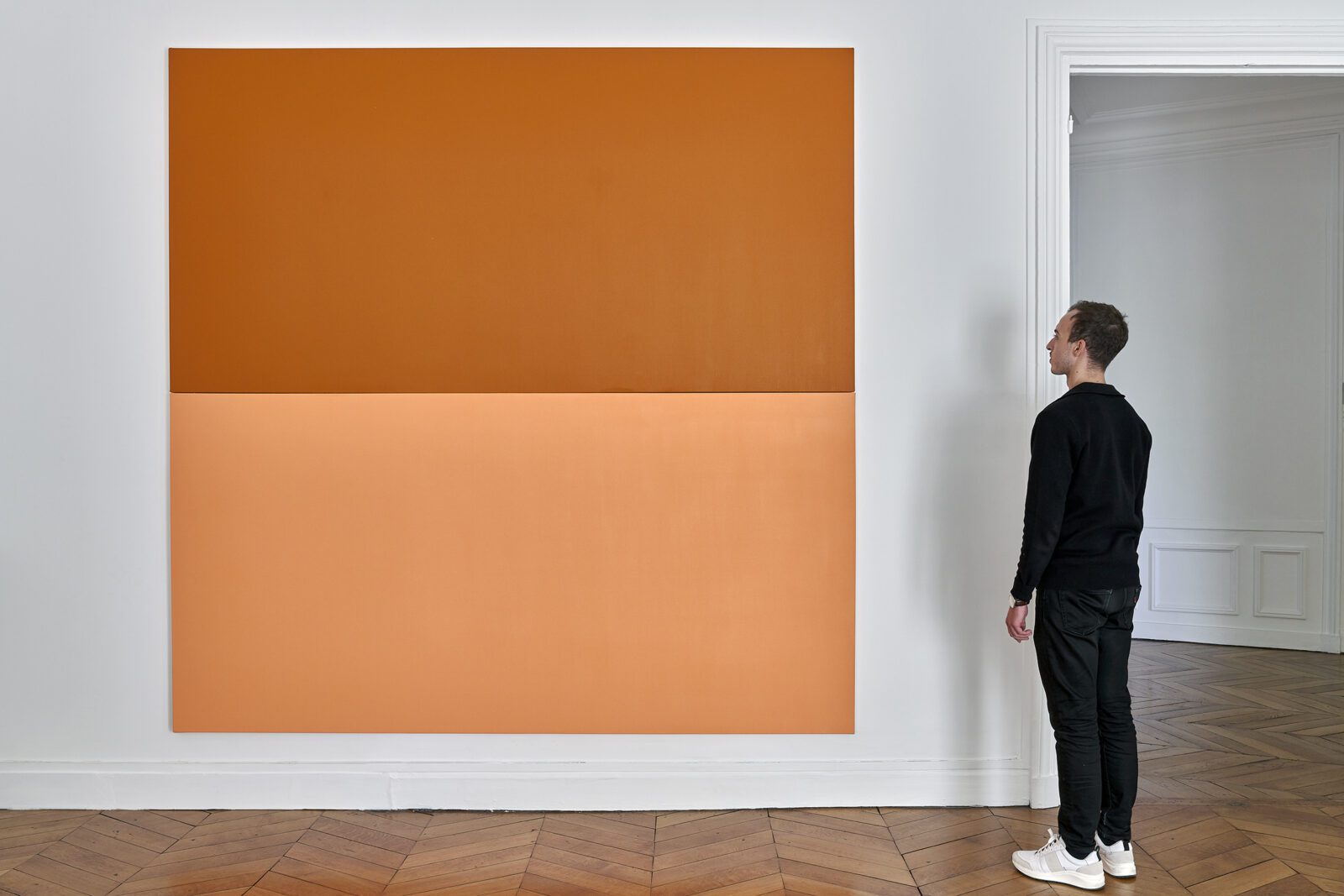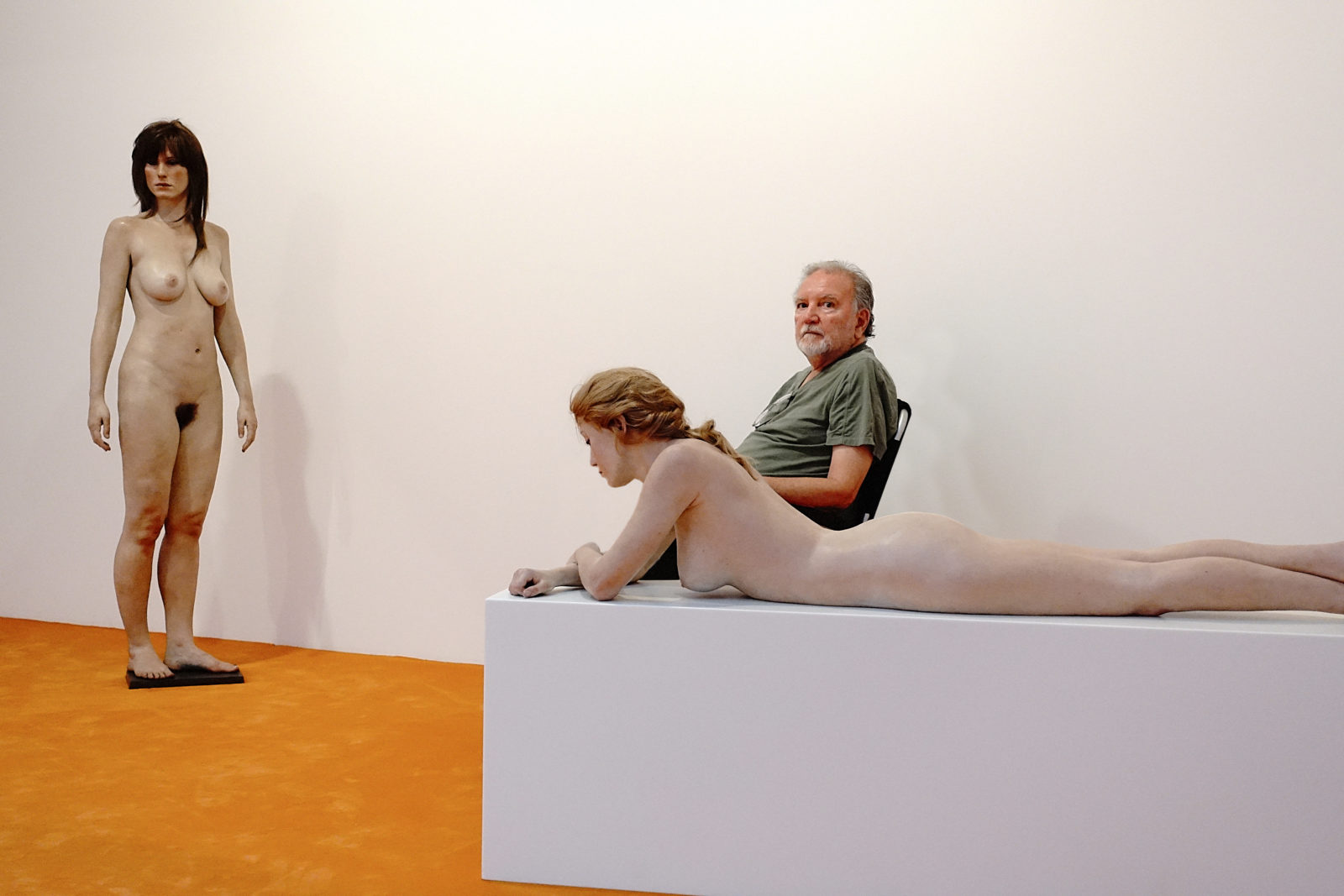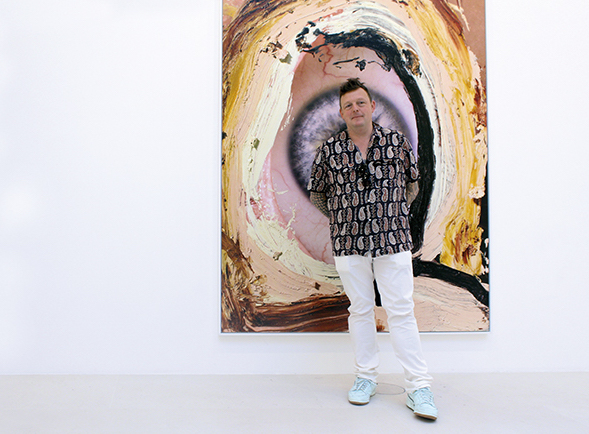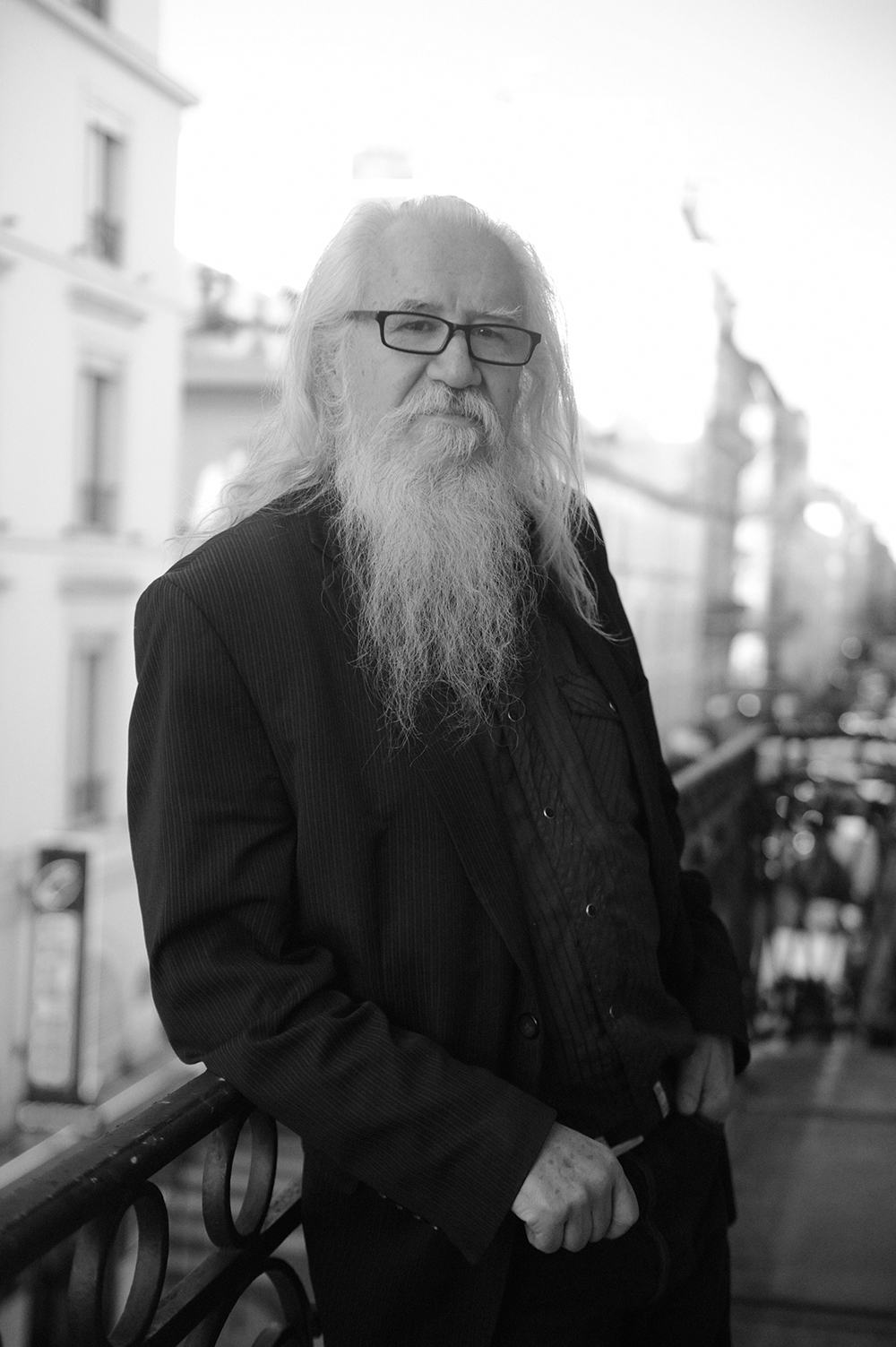
© Elise Toidé
A MEETING WITH OLIVIER MOSSET
By Yan Ceh
Original, offbeat, and odd: artist Olivier Mosset has blazed a trail of his own through art history and around the globe since 1966, trekking from the mountains of Berne, Switzerland to the desert of Tucson, Arizona. On the heels of a recent exhibition of his large monochrome paintings alongside Duane Hanson’s hyperrealist sculptures at Larry Gagosian’s gallery in Paris, the artist met with us to laugh about life and share his anecdotes, thoughts, and ideas in a rare conversation.
It all started for you in Berne, Switzerland, where you were born…
Olivier Mosset: That is correct. Everything started in Berne. I think I was sixteen and just another curious student interested in everything. So I went to the local Kunsthalle for an exhibition of works by Jasper Johns and Robert Rauschenberg. I have to say that the exhibition made quite an impression on me. Especially Rauschenberg, his collages, his montages, his bricolage… It gave me ideas and an urge to create. At the time we thought that American artists were all pranksters… After high school I moved to Paris to go to the Ecole du Louvre, where I did not understand a word… Then I met Jean Tinguely. I offered to become his assistant and he accepted. So I spent a lot of time with him, we traveled together, and I learned so much. It was through him that I got to visit New York for the first time in 1967. We traveled to Canada for one of Jean’s exhibitions and I had saved up to visit the United States during that same trip. As soon as I got to New York, it was like I was in a dream, everything was so new and unexpected. I had heard talk of Andy Warhol’s Factory, so I went there. I thought it was empty when I walked through the door, but then I noticed someone sleeping on the couch, surrounded by walls covered in aluminum. I think it was Billy Name… Warhol was at his desk in another corner, working and setting things in order. I went over to introduce myself and then we went to get coffee. He suggested that I come back the next day to see a concert at the Gymnasium. And that’s how I ended up seeing Velvet Underground with Warhol… I have to admit that there were not very many people at the show… Later on I saw Nico again in Paris, before she started dating Philippe Garrel…
Did it feel like you were living through a historical moment?
OM: Well, not really, because everything seemed incredible to me at the time: being in New York and walking down vast avenues surrounded by immense skyscrapers… Anyway it made me want to go back and I did so several times. I often went to the famous Chelsea Hotel and ran into all sorts of people. I even crossed paths with Leonard Cohen… Eventually I ended up moving to New York in 1977. In the meantime, I had exhibited my work with what was known as the BMPT group (made up of Daniel Buren, Olivier Mosset, Michel Parmentier, and Niele Toroni). What is strange is that we were doing provocative work and telling ourselves that it would never go over well. We did not believe in it at all, but in the end it was a success… Then I spent eight years painting circles on canvas. Actually, it started in 1966 when a director friend of mine asked me for a painting. I cannot quite recall the reason, but I painted a circle in the middle of the canvas. I had spent some time trying to paint, and I liked the idea of doing something “boring”… Boredom is an important part of painting. And I was also interested in the idea of repetition, of painting the same thing over and over again, to question the relative value of an artwork. Part of my intention was also to critique the value assigned to art. All the events of 1968 also played an important role, though the analysis of that time gets it wrong in my opinion. There was a violent break in art with everything that went before. That sense of questioning the result and the act of painting also appeared in minimalist and conceptual art, especially in the United States…
So, as an outsider, you moved to New York in 1977…
OM: Yes, I was drawn to New York and I wanted to live there. When I arrived in 1977 I began a series of monochromes: red on red, white on white. And then I decided to go back to school at Columbia University, so I could get a visa to stay in the country. At Columbia’s School of General Studies, I moved between the visual arts department, which focused on painting models, and the art history department. I took courses in both disciplines, which I felt was important for me, even though I am not too keen on technical performance. However it is interesting to learn what it entails and to grasp the system. But the monochromes I was doing were not really in step with what was going on there at the time. New York in the 80s was more about the return of figurative painting, with David Salle, Julian Schnabel, Francesco Clemente…
Although there was also the Neo Geo movement, with Ashley Bickerton and Peter Halley…
OM: Yes, but I did not really fit in there, either… (laughs) But I still managed to exhibit my work. My spot was the Gibson Gallery, where I notably showed “Fridge” (1986), consisting of two canvases with the same dimensions as a refrigerator. In fact, I remember that the fridge I used for the work came from a piece by Bertrand Lavier, which was also shown at the gallery, in which Bertrand had placed the fridge on something else, a safe or something like that… Compared to Bertrand Lavier or John Armleder, whom I admire deeply, I think I am less ironic in my work… For me, I think a good work of art should represent its non-existence, its insignificance, or a perfect neutrality of sorts. A good work of art should not play the commercial game, even though that is impossible. I also saw Warhol again in New York. In 1985 he was collaborating with Jean-Michel Basquiat. One night someone said, “Andy, can you do something with Olivier, too?” And he replied, “Yes, I can do it right away!” He took a marker out of his jacket and signed my canvas, a yellow monochrome… Several years later, another artist, Michael Zahn, asked me the same question, and I did the same thing…
Another aspect of your artistic universe is your passion for motorcycles…
OM: Yes, you can say that. I like Harley Davidsons a lot. I think that must come from the aftermath of 1968 and the spirit of the 70s. I have four of them now: two in Switzerland and two in Tucson, Arizona where I live and work. For me, motorcycles are like sculptures: they have an aesthetic quality that makes them sculptures. I have even included motorcycles in some of my installations and artwork. It just seems natural to me. Oh, and I also have a 1950 Vincent that belonged to Steve McQueen…
So after twenty years in New York, you moved to Tucson in 1997…
OM: I decided to move there because I married a woman who lives there. So I ended up in the desert. I love it because I do not have to wear a helmet on my motorcycle… I have also explored the surrounding area. I remember going to see Agnes Martin in Santa Fe, New Mexico. It was towards the end of her life, while she was living between a retirement home and her studio. She seemed happy, though we did not say much, as she was a rather quiet person. The desert represents nature and freedom. And cacti. In fact, there is a band from Nantes, called the Little Rabbits, and they came to record in Tucson a little while ago. They later called their tour the Cactus Tour! (laughs)
How do you see the current evolution of contemporary art?
OM: Well, the Internet has changed everything. The thing about my generation is that we all knew each other. We had all heard of all the other artists, even if we had never met them. And we crossed paths at major events like the Venice Biennale or Art Basel… But it is impossible to know every artist today. An unprecedented expansion has taken place, an enormous wave that continues to swell. And we also had an attitude of resistance towards everything that was going on in society. Nowadays, contemporary art is a field like any other. It’s a market, an industry. And there is a multitude of styles. In the past it was possible to have dialogue between movements and systems… That is no longer possible today.
How was the exhibition at Larry Gagosian’s Paris gallery?
OM: They just contacted me and asked if I had any paintings in stock! It was not my idea to pair my paintings with Duane Hanson’s sculptures through the Duane Hanson Estate. So a selection was made among my inventory of paintings at 75 & Park, on Park Avenue in New York, and the canvases were sent to Paris for the exhibition. I thought it was quite well done.
I2, 2015, Polyurethane sprayed on canvas, 75 3/4 x 75 3/4 in.
O2, 2015, Polyurethane sprayed on canvas, 72 7/8 in.






